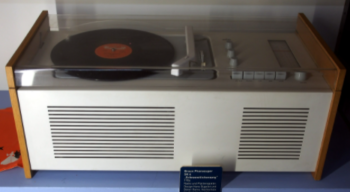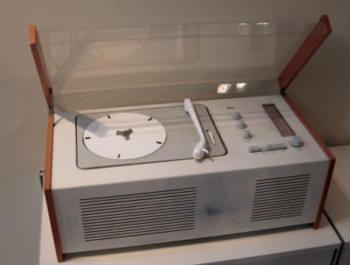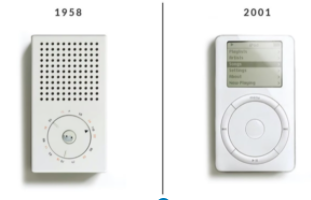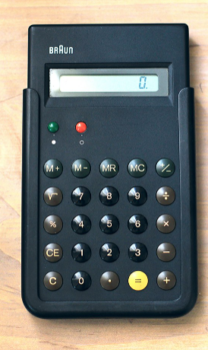Dieter Rams is a German industrial designer who trained and worked as an architect for a few years until he joined the electronic devices manufacturer Braun. Within a few years he became their chief of design, a position he held for almost 35 years. During his tenure, he and his team designed many iconic devices ranging from record players to furniture to storage systems.

Image source:https://search.creativecommons.org/photos/23c7d04a-ffda-42dd-8c33-614fcc7859a8 by renaissancechambara
Biography
Dieter Rams began his studies in architecture and interior decoration at Wiesbaden School of Art in 1947 which is nowadays part of the RheinMain University of Applied Sciences. A year later, in 1948, he took a break from studying to gain practical experience and finish his carpentry apprenticeship. He returned to Wiesbaden School of Art in 1948 and graduated with honours in 1953 after which he began working for Frankfurt-based architect Otto Apel. In 1955, he was recruited to Braun as an architect and an interior designer. In 1961, he became the chief design officer at Braun, a position he retained until 1995.

Image source: https://search.creativecommons.org/photos/612338c9-2339-4211-a6a6-a7a5d0fe32a8 by renaissancechambara
Dieter Rams was strongly influenced by the presence of his grandfather, a carpenter. Rams once explained his design approach in the phrase “Weniger, aber besser” which translates as “Less, but better“. Rams and his staff designed many memorable products for Braun including the famous SK-4 record player and the high-quality ‘D’-series (D45, D46) of 35mm film slide projectors. He is also known for designing a furniture collection for Vitsœ in the 1960s including the 606 universal shelving system and 620 chair programme. By producing electronic gadgets that were remarkable in their austere aesthetic and user friendliness, Rams made Braun a household name in the 1950s.

Image source:https://en.wikipedia.org/wiki/Dieter_Rams#/media/File:1956_Braun_Phonosuper_SK4_Schneewittchensarg.JPG
In addition to being a successor to the Bauhaus, Rams eventually became a protégé of the Ulm School of Design in Ulm, Germany.
As little design as possible
Dieter Rams is one of the most influential product designers of the twentieth century. Even if you don’t immediately recognize his name, you have almost certainly used one of the radios, clocks, lighters, juicers, shelves or hundreds of other products he designed. He is famous not only for this vast array of well-formed products, but for his remarkably prescient ideas about the correct function of design in the messy, out-of-control world we inhabit today. These ideas are summed up in his ‘ten principles‘ of good design: good design is innovative, useful, and aesthetic. Good design should be making a product easily understandable. Good design is unobtrusive, honest, durable, thorough, and concerned with the environment. Most of all, good design is as little design as possible.

Image source: https://search.creativecommons.org/photos/608d60bd-ca95-44a7-999f-65248d861d36
This straightforward list lays out the fundamentals of good design, whether you are designing a logo, designing games or even when designing an app.

Image source: https://search.creativecommons.org/photos/eea6e674-ef74-43d2-a70f-024f54edcc45 by withassociates
- Good Design Is Innovative
The possibilities for innovation are not, by any means, exhausted. Technological development is always offering new opportunities for innovative design. But innovative design always develops in tandem with innovative technology, and can never be an end in itself.
- Good Design Makes a Product Useful
A product is bought to be used. It has to satisfy certain criteria, not only functional but also psychological and aesthetic. Good design emphasizes the usefulness of a product while disregarding anything that could possibly detract from it.
- Good Design Is Aesthetic
The aesthetic quality of a product is integral to its usefulness because products are used every day and have an effect on people and their well-being. Only well-executed objects can be beautiful.
- Good Design Makes A Product Understandable
It clarifies the product’s structure. Better still, it can make the product clearly express its function by making use of the user’s intuition. At best, it is self-explanatory.
- Good Design Is Unobtrusive
Products fulfilling a purpose are like tools. They are neither decorative objects nor works of art. Their design should therefore be both neutral and restrained, to leave room for the user’s self-expression.
- Good Design Is Honest
It does not make a product more innovative, powerful or valuable than it really is. It does not attempt to manipulate the consumer with promises that cannot be kept
- Good Design Is Long-lasting
It avoids being fashionable and therefore never appears antiquated. Unlike fashionable design, it lasts many years – even in today’s throwaway society.
- Good Design Is Thorough Down to the Last Detail
Nothing must be arbitrary or left to chance. Care and accuracy in the design process show respect towards the consumer.
- Good Design Is Environmentally Friendly
Design makes an important contribution to the preservation of the environment. It conserves resources and minimises physical and visual pollution throughout the lifecycle of the product.
- Good Design Is as Little Design as Possible
Less, but better – because it concentrates on the essential aspects, and the products are not burdened with non-essentials. Back to purity, back to simplicity.
Apple and Braun designs
Many believe Dieter Rams is Jonathan Ive’s (Senior Vice President of Industrial Design at Apple) big influence. When the first iPod is compared to the Pocket transistor radio, one can see the similarity in the order and proportion of the two products. The appearance of the calculator application included in Apple’s iOS 3 mimics the appearance of the 1987 Braun ET 66 calculator designed by Rams and Dietrich Lubs, and the appearance of the now playing screen in Apple’s own Podcast app used to mimic the appearance of the Braun TG 60 reel-to-reel tape recorder, before a later redesign of the app removed it.

Image source: https://bellroy.com/journal/heroes-of-design-dieter-rams
Ive makes it no secret that he widely considers Rams as one of his biggest design influences. And the commendation is mutual; Rams has even said that Apple is one of the only companies which follow his ten principles religiously.

Image source:https://search.creativecommons.org/photos/e6172ec9-f591-40e2-b450-f93922b3aea8 by Pinot & Dita
“As designers we have a great responsibility. I believe designers should eliminate the unnecessary. That means eliminating everything that is modish because this kind of thing is only short-lived.”
His work does not try to be the center of attention, rather he allows his work to become part of the environment through precision and order.
Info source: https://en.wikipedia.org/wiki/Dieter_Rams
Info source: https://www.stardust.com/dieter-rams.html
Info source: https://www.apartmenttherapy.com/apple-design-doesnt-fall-far-from-brauns-tree-176668
Info source: https://www.lifeofanarchitect.com/who-is-dieter-rams/
